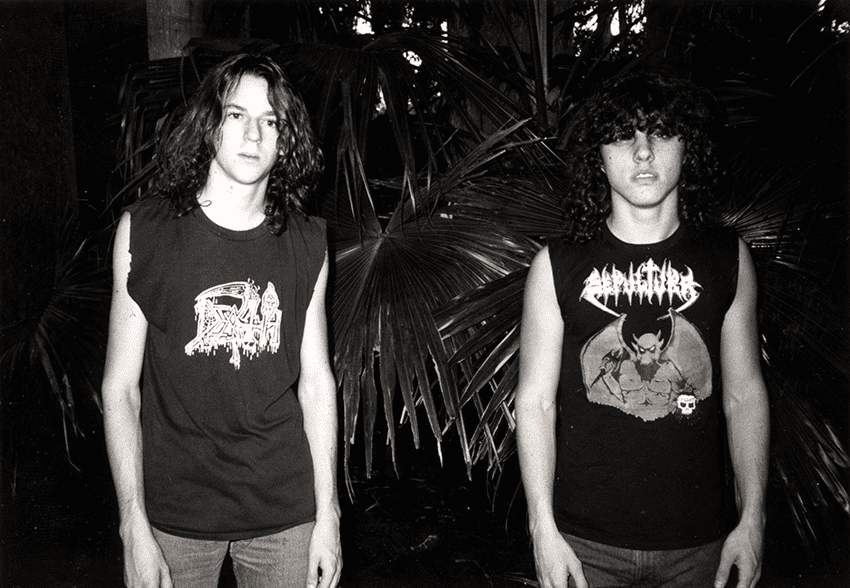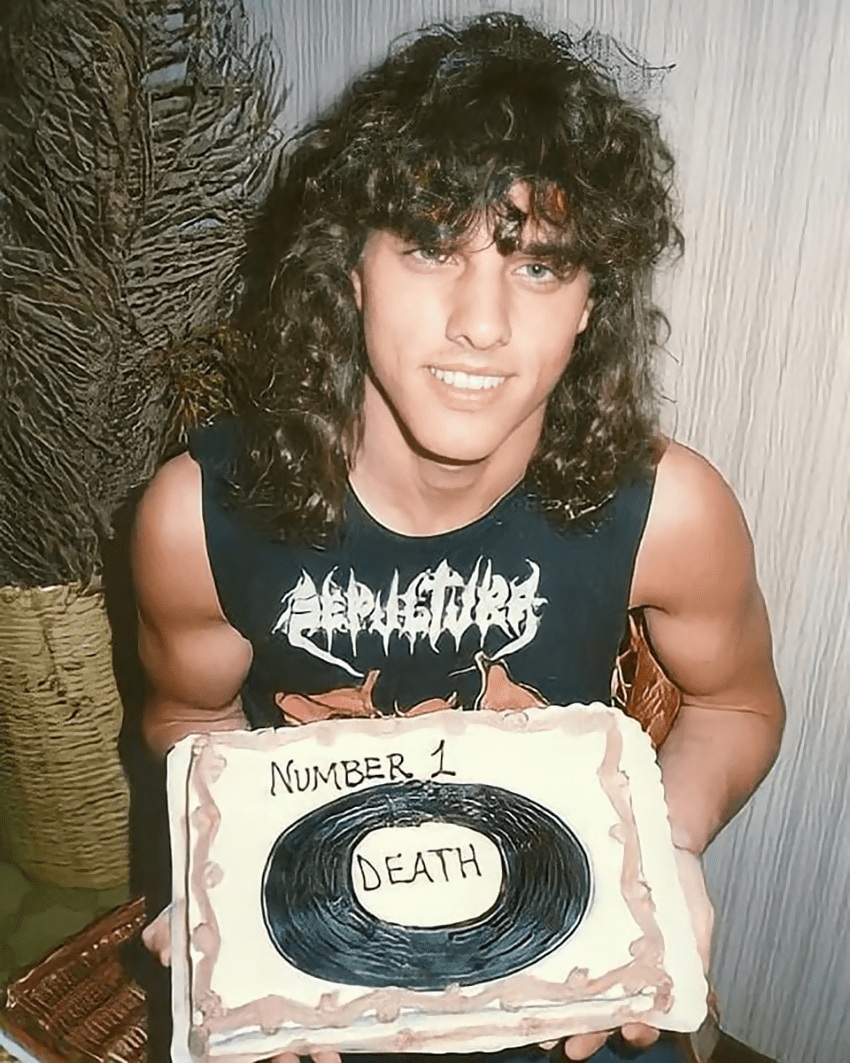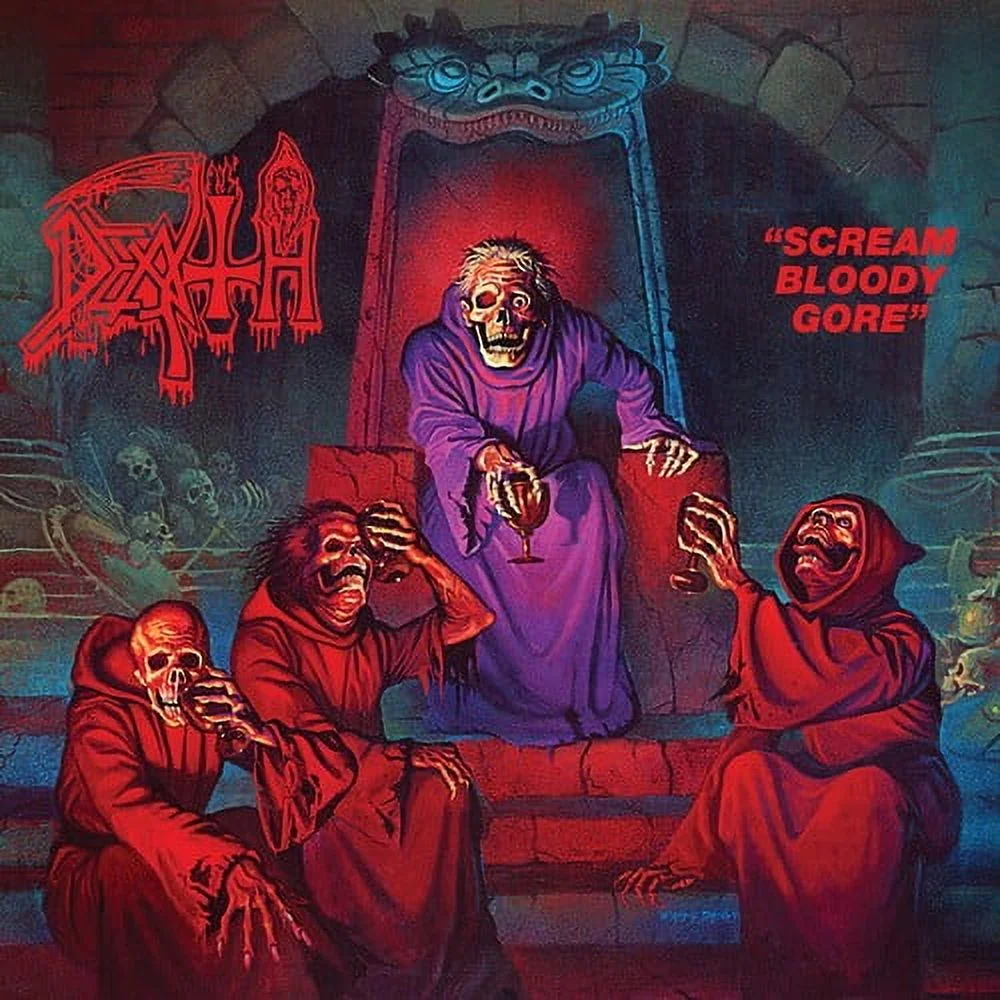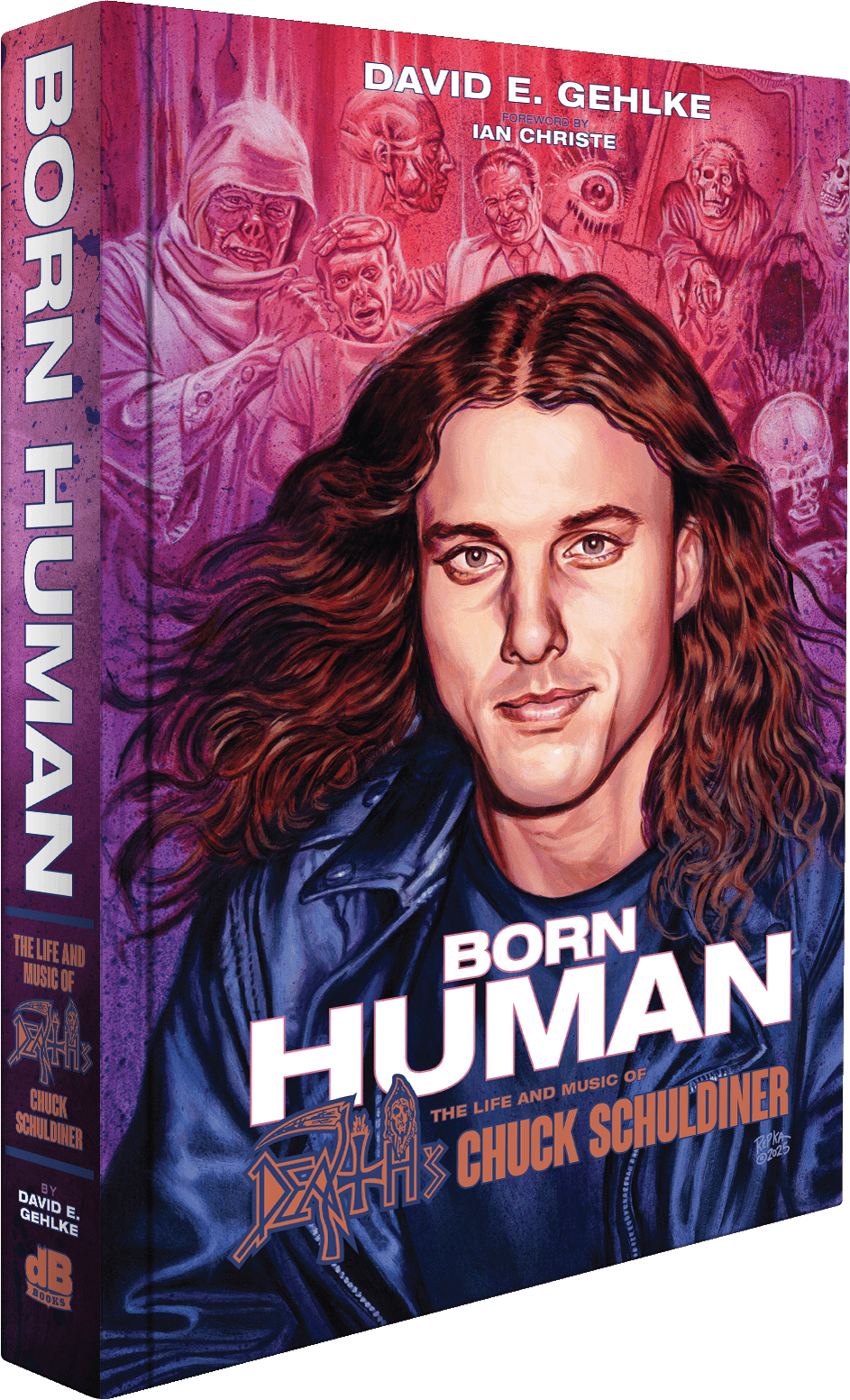Decibel Books proudly presents Born Human: The Life and Music of Demise’s Chuck Schuldiner, the totally licensed biography of the legendary Demise frontman, providing a balanced and unprecedented look into his life and profession. Born Human, authored by achieved journalist David E. Gehlke (The Scott Burns Periods: A Life in Demise Steel 1987-1997, Turned Inside Out: The Official Story of Obituary), options unique interviews, contributions, beautiful new Ed Repka cowl artwork and beforehand unreleased, hand-selected pictures from those that knew Chuck greatest. Born Human brings life to the dramatic story of the person who blazed an iconic path in steel music, laying the inspiration for generations to come back. Followers can pre-order their copy or order a particular Demise-luxe version that features an unique T-shirt restricted to 500 copies right here. Each have an anticipated ship date in November.
A visionary whose groundbreaking recorded output earned him the title of “Godfather of Demise Steel,” Chuck Schuldiner is among the most influential figures in heavy steel historical past. Chuck channeled a tragic childhood into music that was brutal, technical, melodic and progressive, making his band, Demise, a frontrunner inside the steel underground all through the Eighties and Nineteen Nineties. His uncompromising method was accompanied by an often-tumultuous relationship with bandmates, the music business and the press at giant, obstacles he went to nice lengths to beat. When he lastly discovered peace, Chuck was stricken with terminal mind most cancers in 1999. He succumbed to the illness in 2001 after a outstanding struggle that defied the chances.
“We lastly met somebody and we got here to know over time, David E. Gehlke, whom we may entrust with our carefully guarded household secret; this being the inspiration to the painful journey of Chuck’s music,” says Chuck’s sister Beth Welty.
“It’s the end result of various views and experiences, not solely from my household and myself, however from Chuck’s mates, bandmates and numerous individuals who had been infused into his dynamic journey,” provides Chuck’s nephew Chris Steele. “Lastly, there may be an correct and concise chronicle of the person, brother, uncle, son, associate and trailblazer that was Chuck Schuldiner.”
At practically 500 pages, (together with a 32-page shade picture part) Born Human stands because the official doc of Chuck’s incomparable legacy. Pre-order now earlier than its November 2025 launch. European prospects should purchase the usual version of Born Human immediately right here by way of Cult By no means Dies.
For an unique preview of Born Human, followers can learn the primary excerpt on-line, which takes readers again to 1986 as Chuck and new Demise drummer Chris Reifert put together take two of the groundbreaking Scream Bloody Gore album.
——————–
Fight Information hadn’t heard a lot from Chuck and Chris Reifert after being notified that Demise was going to trace Scream Bloody Gore at American Recording Studios in Orlando. Usually, a younger band can be assigned a producer and studio by its file firm, however this was Demise—the brand new Fight signee that solely publicist Don Kaye and some mid-level staff believed would succeed. The truth that Chuck and Reifert may choose the studio confirmed a stunning lack of care and oversight from Fight. Nobody on the label had ever heard of American Recording Studios, nor had Chuck and Reifert earlier than they discovered it within the telephone ebook.
Realizing it was a big purple flag for a younger demise steel band to file at an unknown studio, Fight referred to as Chuck and Reifert for an replace. After a mere two days, the classes had already gone sideways. The employees at American Recording had no thought easy methods to seize the band’s sound irrespective of how a lot gesticulating Chuck did about excessive steel. When Chuck and Reifert talked about different bands as reference factors, their pleas fell on bewildered ears. The preliminary mixes of simply Reifert’s drums and a single guitar observe had been amateurish and practically under demo-level high quality. Alas, Chuck and Reifert had no alternative however to confess that they regretted selecting American Recording. (“We felt like we knew what we had been doing despite the fact that we didn’t,” laughs Reifert.) After one hear, Fight agreed. The label then determined to scrap the classes and ship Demise again to California to file with producer Randy Burns in November 1986.
(Cuts from the preliminary Scream Bloody Gore classes have since emerged on the 2016 reissue of the album. There isn’t a argument with Chuck, Reifert and Fight relating to the abysmal nature of its manufacturing.)
Chuck had each intention of returning to the Bay Space that fall anyway, even when it meant persevering with to crash on Reifert’s bed room ground and having to depend on no matter cash his mother and father, Mal and Jane, may ship by way of the mail. At 19, Chuck was delaying the realities and tasks of maturity for so long as attainable. He didn’t have gainful employment, however he had Reifert, who was nonetheless in highschool and had since moved along with his household to Antioch, three blocks away from Steve Di Giorgio. After spending a number of weeks at his childhood dwelling in Altamonte Springs, post-American Recording session, Chuck was again on the Reiferts.

Right here, Chuck had loads of time to mirror on what he had missed (an training) and what he had not achieved (getting up early within the morning, going to class, doing homework). Throughout this era, Chuck spent most of his daytime working towards the guitar by himself or watching TV, then he would get picked up by Di Giorgio for journeys to the 7/11 comfort retailer for Huge Gulps and jalapeño Fritos, earlier than settling in for some gore motion pictures. In any case of that, it was off to the shared Demise/Sadus follow pad.
Talking of Di Giorgio, he was now very a lot part of Demise’s day-to-day actions with out being an precise member. Chuck and Reifert requested the bassist to study each tune on Scream Bloody Gore with the objective of future Demise/Sadus dwell appearances—a double invoice that Di Giorgio had first urged. In actual fact, each bands had been so positive of joint reveals that they went forward and created mock flyers that includes each of their logos. An actual Demise/Sadus gig must wait—as would Di Giorgio taking part in on a Demise studio album. Surprisingly, Chuck and Reifert by no means requested Di Giorgio to play on the upcoming recording classes with Randy Burns, a possibility that may have possible considerably enhanced the album’s low finish. “We had been simply younger and silly,” says the bassist. “Someday, I picked Chuck and Chris up in my Chevy. They informed me, ‘We’re going to be gone for every week.’ I assumed, ‘Okay, cool. No matter.’ I didn’t suppose something of it, however if you’re 17 or 18 years previous like we had been, you don’t know easy methods to talk. That’s the way you study your classes.”
Unbeknownst to Di Giorgio, Chuck and Reifert had been headed to Los Angeles to file Scream Bloody Gore a second time. For as dangerous because the preliminary model of Scream Bloody Gore sounded, Chuck, Reifert and Fight all forged their worries apart, understanding that Randy Burns was there this time to helm the classes. In any case, he was contemporary off the recording of Darkish Angel’s basic sophomore studio album, Darkness Descends. Just a few months earlier than that, he had produced Megadeth’s basic second album, Peace Sells…However Who’s Shopping for? And some months earlier than that, he was on the controls for Possessed’s basic debut studio album, Seven Church buildings. The commonality between all three (aside from being undisputed classics that Burns recorded) was the Fight title affixed to them.
In 1980, Burns assembled a small eight-track studio referred to as Orange County Recorders. His work caught the eye of future Fight label boss Steve Sinclair, who then tapped him to provide the 1981 Hell Involves Your Home punk compilation launched on the Bemis Mind Information label, which he co-owned. That work led Burns to engineer Suicidal Tendencies’s 1983 self-titled debut. When Sinclair wanted a studio recording achieved rapidly at an inexpensive worth, Burns was his man.
“With out Steve Sinclair, I don’t know whether or not I’d have had a profession or not,” he says. “I used to be good at delivering stuff on a finances, however I used to be very obsessive about making information. I didn’t actually take into consideration cash or making an attempt to turn into well-known. Principally, I’d go from file to file, and after ending one, I’d begin one other. That’s all I did. I didn’t get on the market and take into consideration, ‘Effectively, how do I get extra money, and the way do I get larger budgets?’ I simply didn’t take into consideration that stuff.”
As a substitute, Burns needed to think about easy methods to produce high-quality steel information at a fraction of the price of different albums. (Peace Sells…However Who’s Shopping for? will be seen as an exception as a result of monetary backing of Capital Information, which acquired Megadeth’s rights from Fight.) He confronted some rising pains alongside the way in which, the place he was “making it up” whereas making an attempt to navigate the velocity and depth of maximum steel. Burns met numerous studio homeowners and fellow engineers who believed excessive steel was a misplaced trigger, however he wasn’t discouraged. By the point Chuck and Reifert got here to him to re-track Scream Bloody Gore, Burns felt extra assured as a producer.
A part of this was attributed to his most well-liked place of recording in Los Angeles, the Music Grinder. The Music Grinder was a spacious, trendy facility with a Neve console, which was state-of-the-art for the mid-Eighties. Right here, Burns and his assistant engineer, Casey McMackin, helped Megadeth make an enormous leap in manufacturing high quality with Peace Sells from their tinny and thin-sounding Killing Is My Enterprise…And Enterprise is Good debut. Once they set foot within the studio, the distinction for Demise was additionally quick , and so they marveled on the studio’s measurement and facilities as in comparison with the sterile American Recording in Orlando. Chuck and Reifert’s emotions might have been mildly enhanced by the truth that they had been excessive and had a wholesome reserve of weed stuffed deep of their pockets.
“I used to be stoned and thought, ‘Oh, my God. Can we get to file right here? Holy smokes!’” says Reifert. “It felt like a fucking airline hangar. I don’t know what it might seem like now if I went again, however the Music Grinder felt huge on the time. That was the primary massive studio we had been to. We had been each like, ‘Oh, fuck. That is so cool.’ We had been so excited to be there.”
Burns noticed Chuck and Reifert’s not-so-covert exchanges of hashish. The producer was compelled to play dangerous cop and gently informed the laughing duo that their smoking made him really feel uncomfortable, and that they had been there to work. Fortunately for Burns, Chuck and Reifert got here ready and opted to get “baked out of their minds” after that they had completed recording for the day on the lodge, the place Reifert took it upon himself to eat so many snacks that he vomited. Chuck didn’t match his drummer within the munchies-to-vomiting division—he had the remainder of the album to trace.
Nonetheless, all 12 proposed Scream Bloody Gore cuts had been rehearsed time and again. Chuck and Reifert knew the songs in and out and had practically each aspect of the album agreed upon by the point they arrived on the Music Grinder. With Fight now making use of some strain to get a worthy completed, the Demise duo acquired right down to enterprise.
“I used to be very impressed with their work ethic and the way collectively they had been,” says Burns. “They knew precisely what they wished to do. They might play the songs backward and forwards. Chuck was simply spot-on with the guitars. He actually nailed the stuff. I used to be impressed with the truth that they had been so organized and on prime of the fabric, had been actually arduous staff and targeted within the studio. It’s a tough job making these information.”

The Scream Bloody Gore classes had been lengthy—Chuck, Reifert, Burns and McMackin normally began round 10 within the morning and wrapped at eight at evening. Due to his inflexible follow schedule with Chuck, Reifert wanted just a few days to chop his drums. The Music Grinder featured a 25-foot ceiling product of wooden, contributing mightily to Reifert’s thunderous drums. Burns put Reifert’s package within the nook of the room and let its pure sound take over. “There’s no reverb on his drums,” says the producer. “The drums have this pure darkness to them from the massive room.”
Chuck tracked all rhythm guitars, lead guitars, bass and vocals. He took his elements very severely and was not one to waste time—he rapidly moved on to double-tracking his guitars after the primary layer was full, then moved on to leads. It’s secure to imagine that Chuck circa Scream Bloody Gore was a much better rhythm participant than lead. He by no means discovered music idea and was unable to articulate scales and modes; thus, his solos sometimes displayed a disharmonic aptitude on the album. The lead guitar type that may quickly come to outline the Demise sound was already there: Chuck’s patented bursts of tremolo-picked notes had been at all times well-constructed and even trended within the melodic path on “Evil Useless.”
Scream Bloody Gore is definitely Demise’s most primal studio album. Chuck’s riff repertoire on the time was both manic tremolo selecting or meaty energy chords, with the suitable phalanx of evil guitar harmonies, significantly on the album’s hottest quantity, “Zombie Ritual.” The onus on velocity is a snapshot into how a lot Chuck was listening to Slayer on the time, a band whose seamless transitions and avoidance of riff muddle had been an obvious affect. His riffs are sometimes decidedly easy (for instance, the intro energy chords to “Infernal Demise,” which additionally re-appear on the closing title observe) but extremely efficient and fascinating, such because the chunky “Regurgitated Guts” and the variations discovered on the refrain of “Baptized in Blood.” For as embedded within the firmament as Scream Bloody Gore has turn into, its enduring high quality is a results of simply how catchy and memorable the songs are.
The three-song Mutilation demo showcased Chuck’s capabilities behind the microphone as unforgivingly brutal, but nonetheless decipherable. The identical holds true for Scream Bloody Gore, a efficiency that future demise steel growlers have routinely cited as having a profound affect. Chuck’s patterns and cadences had been simplistic, and he understood the true worth of a memorable passage and refrain. As a substitute of the rapid-fire, word-salad supply that the majority thrash bands (and Possessed) employed, Chuck’s vocal patterns had been deliberate, even affected person, as he was liable to letting his strains breathe.
The album doesn’t lack satisfying moments within the vocal division, although. It begins along with his first phrases on “Infernal Demise:” merely, bluntly, “Die!” From there, the savage couplings discovered within the refrain of “Zombie Ritual” or his acidic mutations within the refrain of “Denial of Life” rank amongst a number of the most memorable vocal strains in demise steel historical past as do his strains within the pre-chorus of “Baptized in Blood” the place Reifert picks up the tempo, or his over-zealous one-liner in “Torn to Items” of “man consuming man!”
The disparity between Chuck’s common talking voice and demise steel vocals initially threw Randy Burns off guard. He wasn’t the one one. Chuck’s pseudo-California-surfer talking voice had lengthy drawn comparisons to Jeff Spicoli, the lovable highschool stoner performed by Sean Penn within the 1982 film Quick Occasions at Ridgemont Excessive. Chuck’s propensity to casually insert “like,” “you understand,” “no matter” and “dude” into his vernacular was usually a supply of amusement and puzzlement for his bandmates and mates. Chuck was born in Lengthy Island, NY. He lived in Altamonte Springs, FL, 1000’s of miles from the California seashores. Nobody can fairly pinpoint why Chuck appeared like a surfer—not even his household, none of whom sound like him. Chuck’s talking voice was finally his and his alone, which made his means to rapidly reel off a number of the most brutal vocals identified to man circa 1986 all of the extra fascinating. (For the curious, practically all interviewees for this ebook, unprompted, stated that Chuck appeared like a surfer.)

A number of of the songs’ lyrics had undergone gentle revisions from the Kam Lee period, beginning with the removing of satanic references. All through his profession, Chuck was by no means keen to cross this line, regardless of by no means totally establishing his non secular stance. Possessed, Slayer and Venom had already staked out the territory, and so had one other Chuck favourite, Danish conventional metallers Mercyful Destiny. On the time, the “t” in Demise’s emblem remained inverted, maybe the one sign that Chuck nonetheless wasn’t able to abandon the band’s early anti-religion angle fully.
Half of the album’s lyrics are generated from Chuck’s horror film assortment. “Zombie Ritual” is predicated upon Zombie 2, “Regurgitated Guts” is from Metropolis of the Residing Useless, “Torn to Items” is drawn from Make Them Die Slowly, “Evil Useless” takes its cues from The Evil Useless, the title observe is impressed by Re-Animator and “Past the Unholy Grave” is taken from The Past. Nonetheless, in step with Chuck’s need to be essentially the most brutal band in steel, the lyrics on Scream Bloody Gore are primitive—at instances even misogynist, significantly “Sacrificial,” which initially went underneath the title of “Sacrificial Cunt.” The title remained in place till Fight intervened out of concern of being confronted by the Dad and mom Music Useful resource Middle (PMRC), which, on the time, was sending shockwaves by the music business by focusing on bands they deemed vile, sexist, satanic or plain previous inappropriate. Because it was quickly to turn into identified, “Sacrificial” is about Possessed fan membership supervisor and one-time Chuck pal Krystal Mahoney, whom he began to disparage with related, unlucky language after their relationship broke down.
“It didn’t take a lot for Chuck to resolve that somebody was a worthy sufficient inspiration for a tune,” says author Borivoj Krgin. “I feel it was simply one thing that he was feeling offended about on the time and wished to precise it in a tune. Was it justified? Most likely not, but it surely was a means for Chuck to vent.”
“I like the truth that Chuck actually understood the factor about being offensive as being one thing that you just need to do,” provides Burns. “I bear in mind I used to be within the studio with one band round this time, perhaps a number of years earlier. They’d a tune, and it stated, ‘Fuck’ within the lyrics. The fellows had been like, ‘Randy, what can we do? Can we depart this in right here, or can we take it out?’ It’s like, ‘You’re not going to be on the radio. Let me ask you this: Would your mother be offended when you left it in?’ They stated, ‘Sure, most likely.’ I stated, ‘There’s your reply. You wish to depart it in.’ Chuck didn’t want any assist with that. He knew precisely what he wished to do.”
Chuck skilled only a few points when slicing vocals for the 12 songs on Scream Bloody Gore, though Burns remembers a number of moments the place he wanted to take a breather. Demise hadn’t performed a dwell present in practically a yr, and Chuck’s stamina was not fairly the place he wished it to be. Chuck had correct vocal method (he hardly ever misplaced his voice), however the depth of the Scream Bloody Gore classes was taxing. “He did these blood-curdling screams—they had been unbelievable,” says Burns. “A few instances, he would do these, and he’d need to go and seize one thing and sit down as a result of he can be just a little dizzy. I used to be actually impressed at simply how intense he was. He put all the things into it.”
Chuck and Reifert emerged largely glad with the Scream Bloody Gore classes. The one downer was that Chuck was not round when Burns blended the album and shortly had complaints that his guitars may have been “louder.” Past that, Chuck and Reifert made good on Fight’s gamble by recording the album a second time. The label and others near Chuck then began to ask how—and when—he was going to finish Demise’s lineup. Once more, logic would assume that they’d have requested Sadus bassist Steve Di Giorgio, who didn’t discover out the pair recorded Scream Bloody Gore till it was too late.
“We had been in my truck smoking a doobie and hanging out,” he says. “Lastly, I requested, ‘So, the place did you go?’ Chuck and Chris paused and stated, ‘Oh, we recorded the album.’ I used to be like, ‘You recorded the album? What do you imply? Did you file the album? Like all of the songs we had been jamming?’ Chuck goes, ‘Yeah, dude. It sucked! I needed to do all of the rhythm guitars, my leads, the bass and vocals. It was an excessive amount of.’ I used to be like, ‘I’ve been right here the entire time jamming with you guys! You could possibly have requested me!’ Reifert hit Chuck within the arm and was like, ‘See! I knew we should always have requested him.’ However I don’t suppose Chuck and Reifert wished to impose. We had been greatest pal bands. I don’t suppose Chuck wished my Sadus guys to really feel like they had been stealing me. Perhaps it’s for the higher.”
With Scream Bloody Gore full and handed over to Fight, Chuck returned to Altamonte Springs for the vacations. It was nonetheless up within the air whether or not Chuck would really return to the Bay Space—he didn’t give Reifert or Di Giorgio a agency dedication both means. Demise, although, was nonetheless a “band” and making inroads towards including new members, which is the place the legend of John Hand begins and rapidly ends.
Pre-order Born Human: The Life and Music of Demise’s Chuck Schuldiner solely from Decibel Books right here.






